The Stainless Steel Maiden, 1916-2020
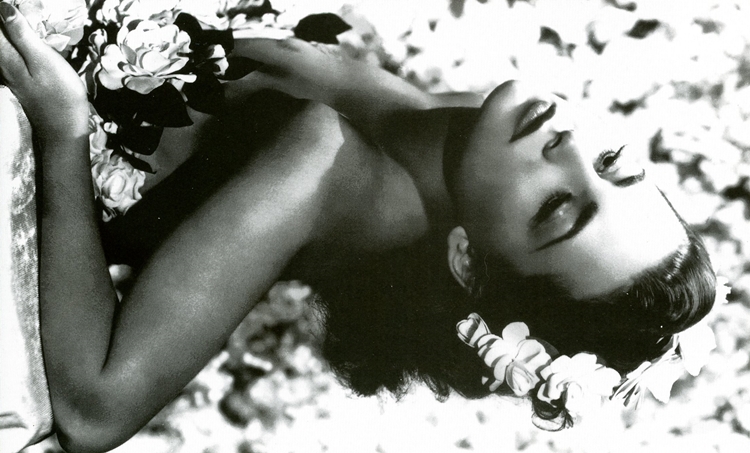
This isn’t the way we usually picture Olivia de Havilland — so naturally it’s one of my favorite photographs of her. This image is reproduced in Robert Matzen’s lavishly illustrated dual study Errol & Olivia: Ego & Obsession in Golden Era Hollywood. Robert’s aim in publishing this pose, along with others from the same photo session, was to refute the assertion of a 1978 biographer that Olivia was “always a lady [but] never sexy”. Well, mission accomplished, says I. “Never sexy”? Ha! Not much.
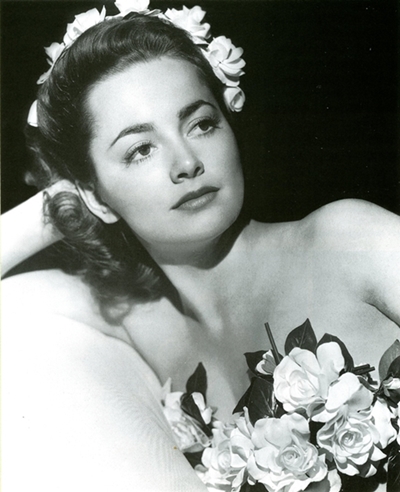
For those who may find that view of Olivia a trifle, ahem, disconcerting, here’s another one from the same sitting. She’s upright this time — less overtly wanton, more watchful and appraising. But she’s still clad in nothing but garlands of strategically-placed flowers — quite literally, la dame aux camelias. These shots were taken by Warner Bros. staff photographer Scotty Welbourne in the summer of 1940, around the time she turned 24. She looks less like Maid Marian or Melanie Wilkes than like Dorothy Lamour in one of her South Seas sarong romances. (Thank you, Scotty Welbourne.)
Olivia left us two weeks ago at the age of 104, making her the world’s longest-lived movie star. In that, she edged out Kirk Douglas, who passed away in February, two months after turning 103. And speaking of those two — it’s odd, isn’t it, to think of Olivia de Havilland and Kirk Douglas as almost exact contemporaries. We tend to think of them as belonging to different generations — which, in point of fact, they did. Douglas got his first Oscar nomination the same year de Havilland got her last (she won, he didn’t). He made his first movie at 29 and became a star at 32; by 32 she’d been a star for fourteen years. And just to put a little cherry on top of the Odd-Isn’t-It Sundae, both of them were brought into movies by Hal B. Wallis — Olivia at Warner Bros., Kirk at Paramount. That Wallis fellow did have an eye for talent.
Strictly speaking, though, the first eye for talent to which we are indebted for Olivia de Havilland belonged to somebody else. In fact, we’re indebted to a whole series of improbable events for the fact that she didn’t live out her life as an obscure schoolteacher whom nobody but her own students had ever heard of. Born in Tokyo in 1916 to an English patent attorney and his wife, a former actress and opera singer, she was two-and-a-half when her mother persuaded her father to move the family to England for the sake of Olivia and her baby sister Joan. They got as far as San Francisco, then the family fell apart. Olivia came down with tonsillitis, Joan with pneumonia (both life-threatening afflictions in those pre-antibiotic days), and their father ran out on them all, returning to Tokyo and the Japanese housekeeper he’d been fooling around with (and whom he later married). Mother de Havilland settled permanently in California with her girls, eventually marrying George M. Fontaine, a manager for Hale Bros. Department Store in San Jose (thus providing a nom de screen for sister Joan when she followed Olivia into movies).
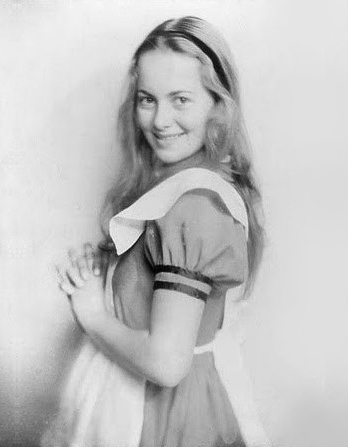 A precocious student with an artistic bent, Olivia caught the acting bug as a teenager, making her debut at 16 playing Lewis Carroll’s Alice for the Saratoga Community Players. Her stepfather, a real petty tyrant, disapproved, and he tried putting his foot down after she was cast in a school production of Pride and Prejudice. None of this acting nonsense, he decreed, not if she wanted to live under his roof — only to learn the lesson others would learn when they tried pushing Olivia de Havilland around: She moved in with a family friend, and the show (and Olivia) went on.
A precocious student with an artistic bent, Olivia caught the acting bug as a teenager, making her debut at 16 playing Lewis Carroll’s Alice for the Saratoga Community Players. Her stepfather, a real petty tyrant, disapproved, and he tried putting his foot down after she was cast in a school production of Pride and Prejudice. None of this acting nonsense, he decreed, not if she wanted to live under his roof — only to learn the lesson others would learn when they tried pushing Olivia de Havilland around: She moved in with a family friend, and the show (and Olivia) went on.
She graduated from Los Gatos High School in 1934 with a scholarship to Mills College in the fall. But first she was cast as Puck in a Saratoga Players production of A Midsummer Night’s Dream. And wouldn’t you know it, that same summer the great Austrian director Max Reinhardt was coming to California to stage Midsummer (his favorite play) at the Hollywood Bowl, Berkeley’s Greek Theatre, and the San Francisco Opera House. And so it was that one of Reinhardt’s assistants, surveying the turf for the Maestro and beating the bush for ensemble talent, stumbled upon 17-year-old Olivia in the hinterlands of Saratoga. Whoever he was (possibly Felix Weissberger, Reinhardt’s credited assistant on the Hollywood Bowl program), he offered her a job carrying a candle in Theseus and Hippolyta’s wedding procession, and as second understudy for the role of Hermia.
Second understudy. Second. Understudy. A dead-end gig if there ever was one. No doubt she was expecting nothing more than a little excitement, a brush with the Reinhardt greatness, and some nifty memories to take with her when she started college in the fall. But wonder of wonders, just a week before opening night at the Bowl, Reinhardt’s Hermia (Gloria Stuart) and her first understudy (Jean Rouverol) both left the company. And Olivia, just turned 18, went on as Hermia, on such short notice that they didn’t even get her name straight in the program (“de Havelland”).
She never made it to Mills College (at least not until 2018, when they awarded her an honorary degree). Hal Wallis caught the Hollywood Bowl engagement of A Midsummer Night’s Dream, he talked Jack Warner into approaching Reinhardt about putting it on film, Reinhardt insisted that Warners cast Olivia in the movie, and Wallis and Henry Blanke (Midsummer‘s line producer) had the good sense to offer her a five-year contract. (Olivia wavered briefly — she still had this idea she wanted to be a teacher — but the money was good for 1934, and she still had the bug, so she signed.)
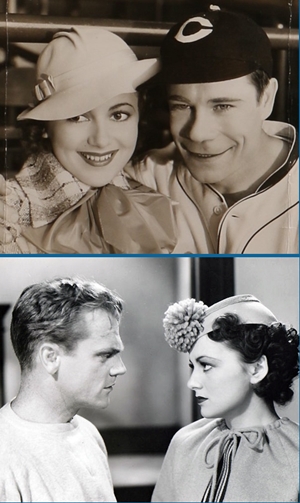
It was as simple — and as quick — as that. One day, Olivia de Havilland is this kid fresh out of high school, doing one last show before knuckling down to college in the fall to become an English teacher. Then whoooooosh! — she’s starring for Max-Freakin’-Reinhardt at the Hollywood Bowl. Then whoooooosh! again — and she’s Warner Bros.’ hot new contract player. That kind of thing happens in corny showbiz movies, not in real life.
A Midsummer Night’s Dream was the first movie Olivia made, but it wasn’t her first one to hit theaters. While Midsummer took shape in the cutting room and got a slow publicity build-up to an October ’35 release, Warner Bros. wasted no time getting their money’s worth out of her. They didn’t shunt her off into supporting “trainer wheel” roles, either. On the contrary, they made her a leading lady to some of the studio’s biggest stars. By age 19, she had dealt with Joe E. Brown’s incessant excuses as Alibi Ike (above), and been double-teamed by Pat O’Brien and James Cagney (below) in The Irish in Us. By the time Midsummer finally opened, she was no longer a lucky unknown promoted out of obscurity; she was an established Warner Bros. star-in-training.

Her next picture completed her training program. Sometimes, becoming a star is a matter of being teamed with the right co-star. No disrespect to Joe E. Brown or Pat O’Brien, but they weren’t a good match for Olivia, nor she for them, and those experiments wouldn’t be repeated. (She would be teamed once more with Cagney in 1941’s The Strawberry Blonde, to good effect.) Then seemingly out of nowhere came this son of a Tasmanian biology professor.
Unlike Olivia, Warner contract player Errol Flynn did get shunted off into trainer wheel parts — a dead body in The Case of the Curious Bride, one of Warren William’s Perry Mason mysteries; three minutes on screen and nine lines in Don’t Bet on Blondes, a screwball comedy also starring Warren William.
Then Warner Bros. decided to bring back the swashbuckler. When they saw the success that United Artists had in 1934 with the British actor Robert Donat as The Count of Monte Cristo, they decided the time was right to dust off Rafael Sabatini’s pirate novel Captain Blood, one of the properties they acquired when they absorbed the Vitagraph Company in 1925. Warners even signed Donat for the lead — but between Donat’s chronic asthma and the fact that he didn’t much like America anyway, he wound up bowing out (Monte Cristo would remain his only Hollywood picture). Jack Warner and Hal Wallis bandied names for a while: Leslie Howard, Clark Gable, Ronald Colman, Brian Aherne, Ian Hunter — and George Brent, of all people (thank God nothing came of that bright idea). Finally, based on a couple of good screen tests and a hunch (Hal Wallis’s eye for talent again), they decided to take a chance and promote Errol overnight from corpse-cum-bit-player to leading man.
And for the haughty English lady whose path crosses Peter Blood’s, with romantic and adventurous consequences for both of them, Warner and Wallis (after floating a trial balloon to W.R. Hearst for Marion Davies) decided to team Errol Flynn with Olivia de Havilland.
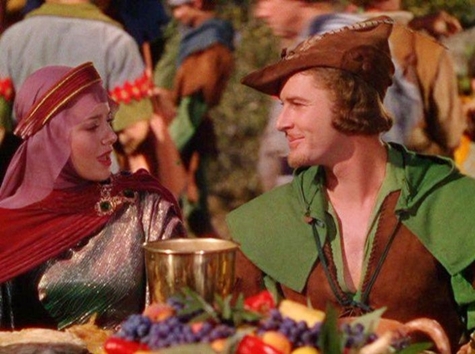 Now before we go on, let’s pause to consider how Captain Blood might have turned out with Robert Donat and Marion Davies. Fortunately, we were spared that. Instead of Donat and Davies, we got Captain Blood with Errol and Olivia, and it made stars of them both. In eight pictures together, they shared a reserved grace that provided a good complement each for the other. Not to mention an erotic chemistry so strong that in those few pictures where their characters don’t end up together — like The Charge of the Light Brigade (1936) and Four’s a Crowd (1938) — something seems distinctly out of whack.
Now before we go on, let’s pause to consider how Captain Blood might have turned out with Robert Donat and Marion Davies. Fortunately, we were spared that. Instead of Donat and Davies, we got Captain Blood with Errol and Olivia, and it made stars of them both. In eight pictures together, they shared a reserved grace that provided a good complement each for the other. Not to mention an erotic chemistry so strong that in those few pictures where their characters don’t end up together — like The Charge of the Light Brigade (1936) and Four’s a Crowd (1938) — something seems distinctly out of whack.
Errol and Olivia reached their apotheosis in 1938’s The Adventures of Robin Hood — not surprising, since that was pretty much an apotheosis for everyone involved, one of the most intoxicatingly flawless movies ever made. Olivia herself didn’t know it for over twenty years; she felt no affinity for Maid Marian, and when director William Keighley was fired and replaced with Michael Curtiz — well, she felt no affinity for Curtiz either. With no confidence in Curtiz or in her own performance, she couldn’t bring herself to see the picture in 1938. Finally, one Saturday in the autumn of 1959, at a loss for some way to amuse her son Benjamin, 10, and daughter Gisèle, 3, she took them to see Robin Hood at a theater near their Paris home. It was a revelation. “I had no idea it was so good,” she recalled. “I thought, good gracious, it’s a classic, it really is a classic! When we made those films we had no idea what we were making, that we were making the best of their kind.”
By that time Olivia and Errol had been estranged for over fifteen years, for some reason that both of them seem to have taken to their graves. In that time they had seen each other only once. Depending on which account you read, it may have been at a charity ball for the costumers’ union in 1957, or maybe at the wrap party for her picture The Proud Rebel in 1958. Either she was disconcerted by this disheveled, staring stranger, or he planted a kiss on the back of her neck and she spun around and slapped him. In any case, she didn’t recognize this puffy, bleary-eyed drunk. “Do I know you?”
“It’s Errol…” She later recalled that she actually said, “Errol who?”
Now, sitting in that Paris cinema with her children, those days of their intimate friendship (which by all accounts had never been more than that) came flooding back. She and the kids sat through the picture twice, then she went home and wrote Errol: “If you haven’t seen the film recently, run it. You will be so proud of it, so glad that you were Robin Hood.” Then she had second thoughts. The letter was awfully sentimental; perhaps she shouldn’t send it. So she didn’t. A few weeks later she got a phone call from a French journalist who warned her he had “some very sad news.” Errol Flynn was dead; would she care to make a statement?
Years later, she said: “I wish I had sent that letter. It would have pleased him after all those years, but I didn’t.”
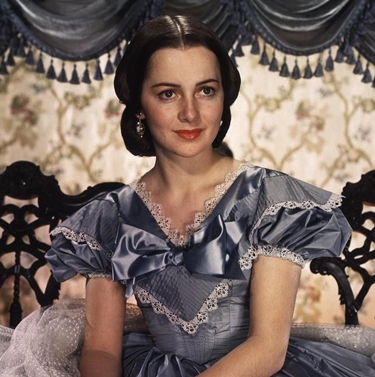
About the time her friendship with Flynn fell by the wayside, in the early 1940s, she was also reaching the end of her rope with Warner Bros. In 1936, in the afterglow of Captain Blood, the studio had offered her a new contract, seven years instead of five, and at a higher weekly salary. Still, it seemed as if Jack L. Warner couldn’t picture her as anything but the damsel in an Errol Flynn adventure movie. It finally began to dawn on Olivia that her best roles — or at least her most personally satisfying — had been on loan-out to other studios. First it had been to Selznick International to play Melanie in Gone With the Wind. Olivia had really wanted that one, and Selznick had really wanted her. But Jack Warner wouldn’t have it — maybe because Selznick had shot down his idea of lending Bette Davis and Errol Flynn for Scarlett and Rhett, maybe just because he enjoyed showing whose name was on the water tower. Anyhow, as all the world knows, J.L. relented in the end — but only because Olivia and his wife Ann double-teamed him. Olivia got to sink her teeth into her first death scene — and came away with her first Oscar nomination. (She lost — as the world also knows — to Hattie McDaniel.)

Next — two years and several damsels later — it was Hold Back the Dawn over at Paramount. Olivia played Emmy Brown, a naïve schoolteacher on a field trip to Tijuana who gets swept off her feet by Charles Boyer as a scheming Romanian refugee seeking to enter the U.S. by — well, by marrying some naïve pushover like Emmy, then dumping her once he’s inside the border. Olivia got her second Oscar nomination, and her second loss.
This one no doubt stung a bit more than losing to Hattie McDaniel in ’39. Also nominated in 1941 was sister Joan Fontaine for Alfred Hitchcock’s Suspicion. It was the first time acting sisters had been nominated against each other — it would happen only once more, with Lynn and Vanessa Redgrave in 1966 (both lost) — and it was the race everyone was following. Joan won.
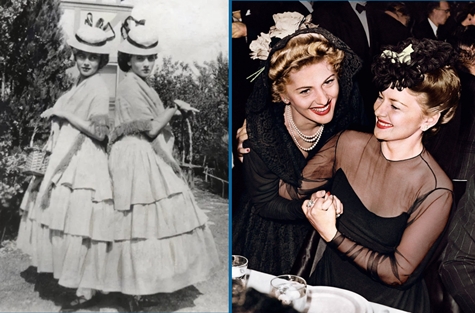
What to say about Olivia and Joan? Their relationship was…complicated. Here are two views of them, as teenagers at a Saratoga garden party, and striking a sporting may-the-best-gal-win pose at the Academy Awards Banquet for 1941 (before any of the winners were announced). In the Saratoga picture they look like conjoined twins, fused at the back and fated never to look in the same direction. It’s an apt metaphor for the most notorious sibling rivalry in Hollywood history.
Surely it didn’t help that they were born only fifteen months apart, making them more like competing twins than anything else. Moreover, they seem to have grown up in a Rashomon universe. Olivia remembered playing big sister and loving it; Joan would climb into bed with her, she recalled, and “put her little head on my shoulder and ask me to tell her a story.” Joan’s recollection differed: “I remember not one act of kindness from Olivia all through my childhood.”
It does seem that Joan went out of her way to compete. She showed no interest in acting until, after living a year or two in Japan with their father and his second wife, she came home in 1934 to find Olivia appearing in Midsummer in San Francisco and on her way to Hollywood. As Olivia told it, Joan’s mantra became “I want to do what you’re doing.” Olivia urged her to finish high school, become a debutante, even a leader in San Francisco society, but Joan refused. As Olivia remembered Joan’s resolve, it was never “I want to be an actress,” or even “I want to be a movie star.” It was always “I want to do what you are doing.”
For her part, Joan remembered only her sister’s petty resentments. “I got married first, got an Academy Award first, had a child first…” True, Joan did get married first — but then, her first husband was Brian Aherne, Olivia’s ex-boyfriend. That might have stuck in Big Sister’s craw. And as for getting the Oscar first — well, Alfred Hitchcock always insisted that it was he and not Joan who created her performance in Suspicion, cobbling together reactions, thoughts, and subtexts in the cutting room that weren’t in evidence on the set. Now we all know that Joan’s talents were (to put it kindly) more modest than Olivia’s. So if Olivia got a little miffed that Joan skated to the winner’s circle on Hitch’s editing tricks while she, Olivia, had done some real acting in Hold Back the Dawn… Well, personally, I’ll cut her a little slack. And “had a child first”? Now Joan is just gloating.
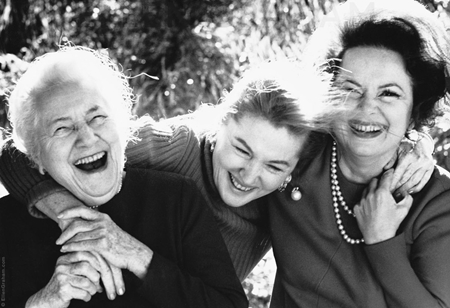 Over the years the sisters — protesting a bit too much, perhaps — would sometimes pose for photos to show that things were just fine between them. They were always burying the hatchet, and always remembering where they left it. The “final schism”, as Joan phrased it, seems to have come with their mother’s terminal illness in 1975. Joan, on tour in Cactus Flower, felt slighted at being excluded from end-of-life treatment decisions; worse, she felt Olivia was dilatory in letting her know when the end was near, so she was still on the road when Mummy breathed her last. At the memorial service, Joan refused to speak to her older sister. Three years later, in her autobiography, Joan, like a volcano that would not stop, spewed sixty years’ worth of pent-up hostility — prompted, perhaps, by still-tender wounds about their mother. In an interview promoting the book she said, “You can divorce your sister as well as your husbands. I don’t see her and I don’t intend to.” In public, Olivia maintained a lofty silence; privately she took to calling Joan the Dragon Lady. Joan titled her memoir No Bed of Roses. Olivia dubbed it No Shred of Truth.
Over the years the sisters — protesting a bit too much, perhaps — would sometimes pose for photos to show that things were just fine between them. They were always burying the hatchet, and always remembering where they left it. The “final schism”, as Joan phrased it, seems to have come with their mother’s terminal illness in 1975. Joan, on tour in Cactus Flower, felt slighted at being excluded from end-of-life treatment decisions; worse, she felt Olivia was dilatory in letting her know when the end was near, so she was still on the road when Mummy breathed her last. At the memorial service, Joan refused to speak to her older sister. Three years later, in her autobiography, Joan, like a volcano that would not stop, spewed sixty years’ worth of pent-up hostility — prompted, perhaps, by still-tender wounds about their mother. In an interview promoting the book she said, “You can divorce your sister as well as your husbands. I don’t see her and I don’t intend to.” In public, Olivia maintained a lofty silence; privately she took to calling Joan the Dragon Lady. Joan titled her memoir No Bed of Roses. Olivia dubbed it No Shred of Truth.
 Olivia eventually got her own Oscar, of course. Two of them, in fact, and both at Paramount, the studio that had borrowed her for Hold Back the Dawn. First, in 1946, came To Each His Own. Olivia played an unwed mother who, when her lover is killed in World War I, is forced to give up her baby to be adopted by an old frenemy, then to watch from afar as the boy grows up, thinking of her only as a fussy and rather pathetic family friend. It was, in Oscar historian Robert Osborne’s apt phrase, “a Tiffany tear-jerker”. In the movie’s final scene, when the boy, now grown to manhood, finally gets it through his head why “Aunt Jody” has always been so nice to him, and says to her, “May I have this dance…Mother?” — the look on Olivia’s face is enough to reduce a bronze statue to helpless sobs.
Olivia eventually got her own Oscar, of course. Two of them, in fact, and both at Paramount, the studio that had borrowed her for Hold Back the Dawn. First, in 1946, came To Each His Own. Olivia played an unwed mother who, when her lover is killed in World War I, is forced to give up her baby to be adopted by an old frenemy, then to watch from afar as the boy grows up, thinking of her only as a fussy and rather pathetic family friend. It was, in Oscar historian Robert Osborne’s apt phrase, “a Tiffany tear-jerker”. In the movie’s final scene, when the boy, now grown to manhood, finally gets it through his head why “Aunt Jody” has always been so nice to him, and says to her, “May I have this dance…Mother?” — the look on Olivia’s face is enough to reduce a bronze statue to helpless sobs.
Then three years later came The Heiress, from the play by Ruth and Augustus Goetz based on Henry James’s novel Washington Square. As James’s timid, insecure heroine beset with, on one hand, a father whose pretended solicitude masks a withering contempt, and on the other, an ardent suitor who may only be after her money, Olivia gave perhaps her finest performance (although her turn as a mental patient in 1948’s The Snake Pit would be up there as well; she was nominated for that one too). So Joan may boast of winning her Oscar first, but Olivia matched her, and raised her one. Not only that, but Olivia (like Joan) earned her awards working for A-list directors (Mitchell Leisen on To Each His Own, William Wyler on The Heiress) — and neither of them ever said that he had to do Olivia’s acting for her.
But the truth is, even without those well-deserved Oscars, by 1946 she had already earned her place in the history books — and all because she finally had it to here with Jack L. Warner. Perhaps Warner wanted to punish her for that end run to his wife over Gone With the Wind, or maybe he was just being his usual boorish, obtuse, screw-the-talent self. Either way, Olivia found herself being offered an unvarying succession of two-dimensional ingenues; every time she turned one down she’d go on suspension. As 1942 turned into 1943, she was counting the days until her seven-year contract ran out in May. Then came a nasty shock: Warner informed her that the time she’d spent on suspension was being added to the end of her contract, another twenty-five weeks.
Any other contract star might have simply gritted her teeth and ridden out those six months, doing whatever Jack Warner threw at her just to be done with the studio, and with him. But this was one of those moments, like the showdown with George Fontaine over that high-school production of Pride and Prejudice, that showed what Olivia de Havilland was made of. In August 1943 she sued.
Jack Warner had dealt with rebellious stars before. Bette Davis had sued in British court to get out of her contract and lost; James Cagney had sued for breach of contract and — because Warners had clearly breached — fought the studio to a draw. This time J.L. wasn’t giving an inch; besides, Bette Davis and James Cagney had been (and were still) bigger stars than Olivia de Havilland.
But Olivia had a good lawyer, one Martin Gang. He found California Labor Code (CLC) Sec. 2855, which limited a personal-services contract to no more than seven years. The Hollywood studios had always interpreted that to mean seven years of actual work; Gang argued that such a limit was really no limit at all, and that the law must mean seven calendar years. Since her contract had been signed on May 5, 1936, he said, it had run out on May 5, 1943.
The Superior Court of California agreed, and so did the Court of Appeals. In February 1945 the State Supreme Court declined to hear the case, and Olivia was a free agent. She hadn’t worked in nearly two years and had run up steep legal fees, squeaking by on the occasional radio gig. Jack Warner effectively blacklisted her; as far as the studio was concerned she was still under suspension, and he wrote personally to every production company in America warning them not to hire her. But now it was over, she had won, and it was worth it.
And not only for her. She had broken what was essentially a system of indentured servitude in which the studios had all the power and the stars had none. No more. Henceforth movie actors — indeed, anyone under contract for anything — would have much more control over their careers because Olivia de Havilland wouldn’t let Jack Warner push her around. And Hollywood seemed to respect her for it. Her first picture after the long dry spell was To Each His Own, and the Academy Award may have been as much a tribute to her legal victory as it was to her performance.
In his book Errol & Olivia, Robert Matzen suggests that the forced hiatus while her lawsuit trudged through the courts stunted Olivia’s momentum, causing her to “lose a chunk of her career as a youthful leading lady during three of Hollywood’s last good years” — and there’s something to that. Still, there were those two Oscars, plus a nomination for The Snake Pit — those three pictures probably constituting her best performances. If the shadow of Gone With the Wind loomed over the rest of her life — well, she wasn’t alone in that. And if her career turned down after 1950 — whose didn’t? She worked when she felt like it, and when she didn’t, she was happy at home in Paris, where she relocated with her second marriage to Paris Match editor Pierre Galante in 1955 (they divorced in 1979 but remained good friends, and she tended him as he lay dying of cancer in 1998).
Her last performance came in 1988, as the aunt of the future Duchess of Windsor in a TV movie about the abdication of Edward VIII; her last credit, narrating a 2009 documentary about art therapy for Alzheimer’s patients. Otherwise, it was a comfortable dowager retirement in her home near the Bois de Boulogne overlooking the Seine, sprinkled with life-achievement honors — including, at the age of 100, being made Dame Commander of the Order of the British Empire. So be it duly noted, she died not simply Ms. de Havilland, but Dame Olivia.
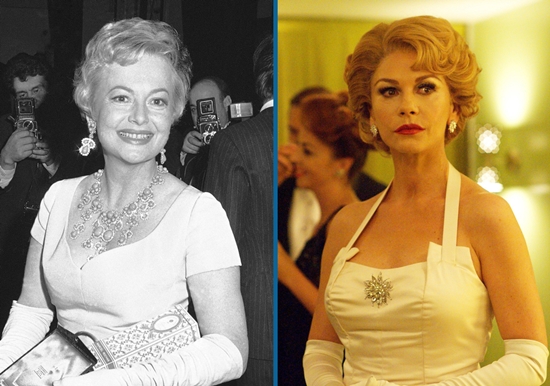 Also at 100, she showed the world that there was litigation in the old girl yet. She sued FX Networks and producer Ryan Murphy over Feud: Bette and Joan, an eight-part miniseries that purported to dish the dirt on the making of What Ever Happened to Baby Jane? in 1962 and the diva-rivalry between Bette Davis and Joan Crawford. Olivia had been a good friend of Bette’s, and she replaced Joan when she was fired from her and Bette’s follow-up teaming on Hush…Hush, Sweet Charlotte (1964), so Olivia was represented as a supporting character in the miniseries, and played by Catherine Zeta-Jones. As these two pictures suggest, neither Ms. Zeta-Jones, her costumer, nor her hairdresser gave much evidence of ever having seen or heard of Olivia. Neither did any of the writers, and that’s what she sued over, charging that her privacy had been invaded without her permission or input, that she had been slandered and misrepresented. True enough; Feud was sleazy stuff, despite all the A-list names, and it misrepresented pretty much everybody it mentioned. The only reason Olivia was the only plaintiff in the case is that she was the only one who was still alive.
Also at 100, she showed the world that there was litigation in the old girl yet. She sued FX Networks and producer Ryan Murphy over Feud: Bette and Joan, an eight-part miniseries that purported to dish the dirt on the making of What Ever Happened to Baby Jane? in 1962 and the diva-rivalry between Bette Davis and Joan Crawford. Olivia had been a good friend of Bette’s, and she replaced Joan when she was fired from her and Bette’s follow-up teaming on Hush…Hush, Sweet Charlotte (1964), so Olivia was represented as a supporting character in the miniseries, and played by Catherine Zeta-Jones. As these two pictures suggest, neither Ms. Zeta-Jones, her costumer, nor her hairdresser gave much evidence of ever having seen or heard of Olivia. Neither did any of the writers, and that’s what she sued over, charging that her privacy had been invaded without her permission or input, that she had been slandered and misrepresented. True enough; Feud was sleazy stuff, despite all the A-list names, and it misrepresented pretty much everybody it mentioned. The only reason Olivia was the only plaintiff in the case is that she was the only one who was still alive.
The case got fast-tracked out of deference to Olivia’s advanced age, but nobody expected her to prevail, and she didn’t. Feud: Bette and Joan, distasteful as it was, was ruled to be protected First Amendment speech. Turns out it’s not against the law for someone to make a lousy movie, even if it’s about you, and on balance that’s no doubt a good thing; America’s prisons are crowded enough. Still, if there’s anything to karma, someday somebody will make a miniseries that does to Susan Sarandon, Jessica Lange, Alfred Molina and Judy Davis what they did to (respectively) Bette Davis, Joan Crawford, director Robert Aldrich and gossip columnist Hedda Hopper. For that matter, Catherine Zeta-Jones won’t get off scot-free either.
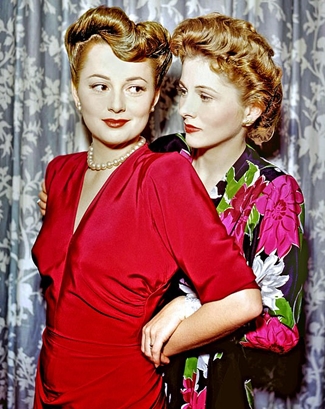
So Olivia lost that one, but she made her point: she still didn’t like being pushed around. Besides, I wonder if she didn’t have a longer game in mind. Feud was originally pitched by Ryan Murphy as an ongoing project, with each season consisting of an eight-part miniseries dramatizing some famous celebrity feud. Bette and Joan was simply Season One; Season Two would deal with Charles and Diana. Was Olivia’s lawsuit a proactive move, a shot across Ryan Murphy’s bow warning him not to plot out any episodes for Feud: Olivia and Joan? If so, maybe she could claim a strategic victory: it’s been three years now and there are still no plans for a Season Two of Feud (though Ryan Murphy has reserved the right to reanimate the project).
Over the years, Olivia granted a reasonable number of interviews, and she always graciously answered fan mail. But she frequently turned aside specific questions by saying that she would deal with that in her memoirs. Did she really write them, I wonder, or was that just her way of dodging nosy questions from strangers? I suppose we’ll find out sooner or later. If there is a manuscript somewhere in that house in Paris, I imagine it will be complete without being laborious, honest without being cruel, dignified without being snooty, assertive without being rude, and strong without being vulgar. Pretty much the way she was in all her movies — and, as far as anyone ever knew, in real life.
